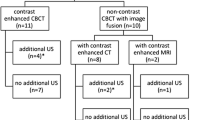Abstract
Purpose
To retrospectively evaluate the usefulness of virtual fluoroscopic preprocedural planning (VFPP) in the percutaneous transhepatic biliary drainage (PTBD) procedure.
Materials and Methods
Twenty-two patients who were treated by PTBD were included in this study. Twelve patients were treated using PTBD intraoperative referencing coronal computed tomography (CT) images (i.e., coronal CT group), and ten patients were treated using PTBD intraoperative referencing VFPP images (i.e., VFPP group). To analyze the effect of the intraoperative referencing VFPP image, the VFPP group was retrospectively compared with the coronal CT group.
Results
The characteristics of both patient groups were not statistically significantly different. There were no significant differences in the targeted bile duct, diameter and depth of the target bile, breath-holding ability, number of targeted bile duct puncture attempts, change in the targeted bile duct, and exchange of the drainage catheter. However, the X-ray fluoroscopy time and the procedure time were significantly shorter in the VFPP group than in the coronal CT group (196 vs. 334 s, P < 0.05; and 16.0 vs. 27.2 min, P < 0.05).
Conclusion
Intraoperative referencing using the VFPP imaging in PTBD intuitively can be a useful tool for better localization of the guidewire in the bile duct and thereby shorten the X-ray fluoroscopy time and procedure time while minimizing radiation exposure and complications.



Similar content being viewed by others
References
Takada T, Hanyu F, Kobayashi S, Uchida Y. Percutaneous transhepatic cholangial drainage: direct approach under fluoroscopic control. J Surg Oncol. 1976;8:83–97.
Makuuchi M, Bandai Y, Ito T, Watanabe G, Wada T, Abe H, Muroi T. Ultrasonically percutaneous transhepatic bile drainage: a single-step procedure without cholangiography. Radiology. 1980;136:165–9.
Baxter-Smith DC, Temple JG, Howarth F. Palliative percutaneous transhepatic drainage for inoperable obstructive jaundice. Ann R Coll Surg Engl. 1982;64:394–6.
Nagino M, Hayakawa N, Nimura Y, Dohke M, Kitagawa S. Percutaneous transhepatic biliary drainage in patients with malignant biliary obstruction of the hepatic confluence. Hepato-gastroenterology. 1992;39:296–300.
Saad WE, Wallace MJ, Wojak JC, Kundu S, Cardella JF. Quality improvement guidelines for percutaneous transhepatic cholangiography, biliary drainage, and percutaneous cholecystostomy. J Vasc Interv Radiol. 2010;21:789–95.
Hamlin J, Friedman M, Stein M, Bray J. Percutaneous biliary drainage: complications of 118 consecutive catheterizations. Radiology. 1986;158:199–202.
Covey AM, Brown KT. Percutaneous transhepatic biliary drainage. Tech Vasc Interv Radiol. 2008;11:14–20.
Saluja SS, Gulati M, Garg PK, Pal H, Pal S, Sahni P, Chattopadhyay TK. Endoscopic or percutaneous biliary drainage for gallbladder cancer: a randomized trial and quality of life assessment. Clin Gastroenterol Hepatol. 2008;6:944–50.
Walter T, Ho CS, Horgan AM, Warkentin A, Gallinger S, Greig PD, Kortan P, Knox JJ. Endoscopic or percutaneous biliary drainage for Klatskin tumors? J Vasc Interv Radiol. 2013;24:113–21.
Madhusudhan KS, Gamanagatti S, Srivastava DN, Gupta AK. Radiological interventions in malignant biliary obstruction. World J Radiol. 2016;8:518–29.
Fukusumi M, Ichinose Y, Arimoto Y, Takeoka S, Homma C, Matsuoka H, Mouri A, Hamamoto Y, Matsumoto J, Kamimura M. Bronchoscopy for pulmonary peripheral lesions with virtual fluoroscopic preprocedural planning combined with EBUS-GS: a pilot study. J Bronchol Interv Pulmonol. 2016;23:92–7.
Miyayama S, Yamashiro M, Hashimoto M, Hashimoto N, Ikuno M, Okumura K, Yoshida M, Matsui O. Identification of small hepatocellular carcinoma and tumor-feeding branches with cone-beam CT guidance technology during transcatheter arterial chemoembolization. J Vasc Interv Radiol. 2013;24:501–8.
Miyayama S, Yamashiro M, Ikuno M, Okumura K, Yoshida M. Ultraselective transcatheter arterial chemoembolization for small hepatocellular carcinoma guided by automated tumor-feeders detection software: technical success and short-term tumor response. Abdom Imaging. 2014;39:645–56.
Sailer AM, de Haan MW, de Graaf R, van Zwam WH, Schurink GWH, Nelemans PJ, Wildberger JE, Das M. Fusion guidance in endovascular peripheral artery interventions: a feasibility study. Cardiovasc Interv Radiol. 2015;38:314–21.
Kloeckner R, Bersch A, Dos Santos DP, Schneider J, Düber C, Pitton MB. Radiation exposure in nonvascular fluoroscopy-guided interventional procedures. Cardiovasc Interv Radiol. 2012;35:613–20.
Author information
Authors and Affiliations
Corresponding author
Ethics declarations
Conflict of interest
The authors have no conflicts of interest to declare.
Rights and permissions
About this article
Cite this article
Kinoshita, M., Shirono, R., Takechi, K. et al. The Usefulness of Virtual Fluoroscopic Preprocedural Planning During Percutaneous Transhepatic Biliary Drainage. Cardiovasc Intervent Radiol 40, 894–901 (2017). https://doi.org/10.1007/s00270-017-1581-9
Received:
Accepted:
Published:
Issue Date:
DOI: https://doi.org/10.1007/s00270-017-1581-9




